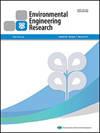Novel nanocomposite thin films for efficient degradation of Rhodamine B and Rhodamine 6G under visible light irradiation: Reaction Mechanism and Pathway studies
IF 3
4区 环境科学与生态学
Q3 ENGINEERING, ENVIRONMENTAL
引用次数: 1
Abstract
The present investigation aims to synthesize the novel nanocomposite thin film and utilize the material to remove emerging dyes efficiently (i.e., Rhodamine B (R-B) and Rhodamine 6G (R-6G)), in an aqueous solution using LED visible light and UV-A light. A facile synthetic route was adopted to obtain the TiO2-supported bentonite and in situ decorated with Au nanoparticles (NPs) thin film. The advanced analytical techniques characterizes the materials. The laboratory scale reactor was utilized for efficient degradation of R-B and R-6G using thin film catalysts. The percentage removal of R-B was 54.13% (visible light) and 76.26% (UV-A light) and the R-6G, was removed 60.37% (visible light) and 84.68% (UV-A light) at the initial pollutant concentration of 0.5 mg/L and at pH 6.0 using the thin film photocatalyst. The parametric studies demonstrated the insights of degradation mechanisms in photocatalytic operations. A significant mineralization of these dyes is achieved, and the repeated use in reactor operations indicated the catalysts新型纳米复合薄膜在可见光照射下有效降解罗丹明B和罗丹明6G:反应机理和途径研究
本研究旨在合成新型纳米复合薄膜,并利用该材料在使用LED可见光和UV-A光的水溶液中有效去除新兴染料(即罗丹明B(R-B)和罗丹明6G(R-6G))。采用简单的合成路线获得了TiO2负载的膨润土,并用Au纳米粒子(NPs)薄膜原位修饰。先进的分析技术是材料的特点。实验室规模的反应器用于使用薄膜催化剂有效降解R-B和R-6G。使用薄膜光催化剂,在污染物初始浓度为0.5mg/L和pH为6.0时,R-B的去除率为54.13%(可见光)和76.26%(UV-A光),R-6G的去除率分别为60.37%(可见光和84.68%(UV-A)。参数研究证明了对光催化操作中降解机制的深入了解。这些染料实现了显著的矿化,在反应器操作中的重复使用表明了催化剂
本文章由计算机程序翻译,如有差异,请以英文原文为准。
求助全文
约1分钟内获得全文
求助全文
来源期刊

Environmental Engineering Research
Environmental Science-Environmental Engineering
CiteScore
7.50
自引率
5.70%
发文量
80
期刊介绍:
The Environmental Engineering Research (EER) is published quarterly by the Korean Society of Environmental Engineers (KSEE). The EER covers a broad spectrum of the science and technology of air, soil, and water management while emphasizing scientific and engineering solutions to environmental issues encountered in industrialization and urbanization. Particularly, interdisciplinary topics and multi-regional/global impacts (including eco-system and human health) of environmental pollution as well as scientific and engineering aspects of novel technologies are considered favorably. The scope of the Journal includes the following areas, but is not limited to:
1. Atmospheric Environment & Climate Change: Global and local climate change, greenhouse gas control, and air quality modeling.
2. Renewable Energy & Waste Management: Energy recovery from waste, incineration, landfill, and green energy.
3. Environmental Biotechnology & Ecology: Nano-biosensor, environmental genomics, bioenergy, and environmental eco-engineering.
4. Physical & Chemical Technology: Membrane technology and advanced oxidation.
5. Environmental System Engineering: Seawater desalination, ICA (instrument, control, and automation), and water reuse.
6. Environmental Health & Toxicology: Micropollutants, hazardous materials, ecotoxicity, and environmental risk assessment.
 求助内容:
求助内容: 应助结果提醒方式:
应助结果提醒方式:


